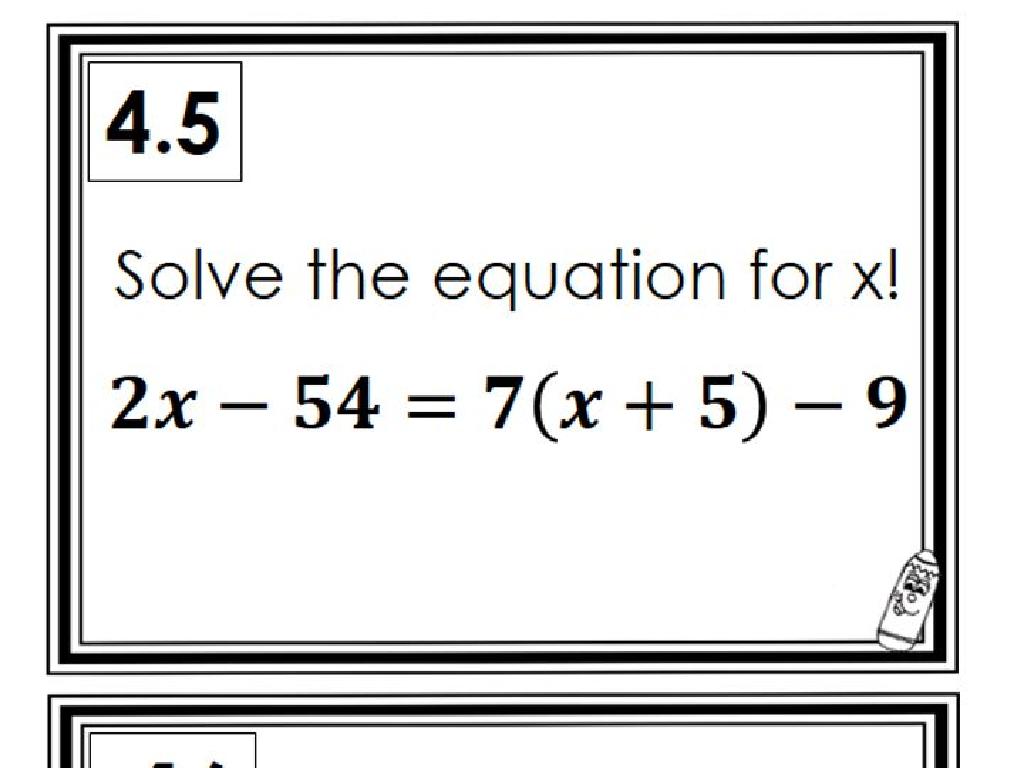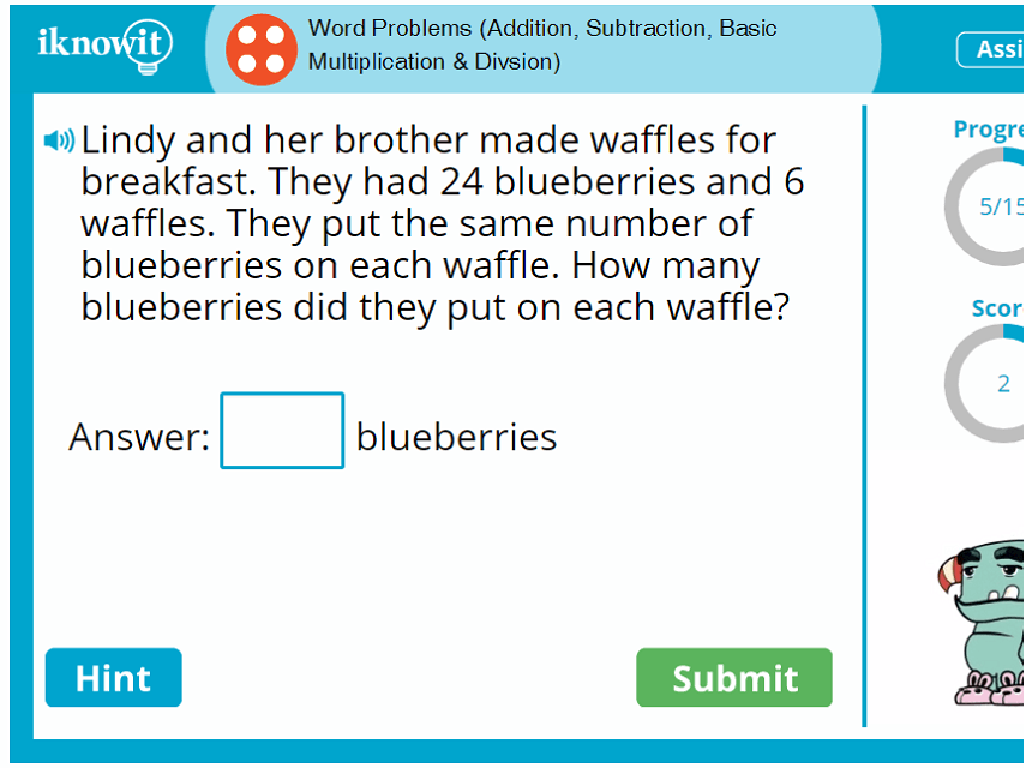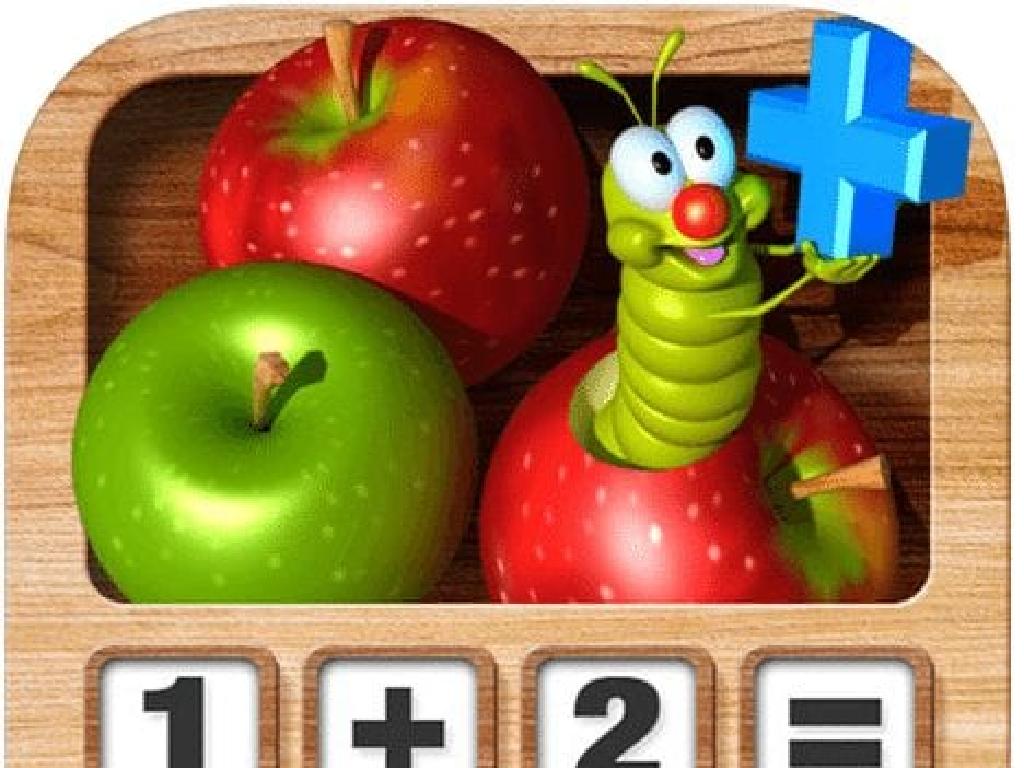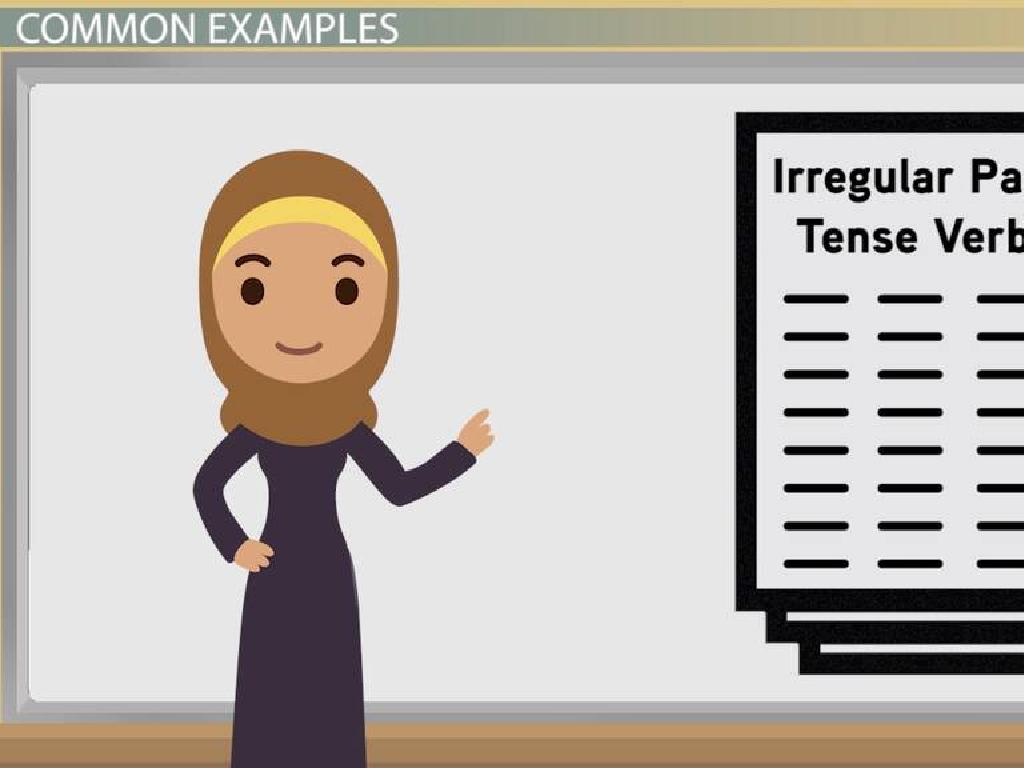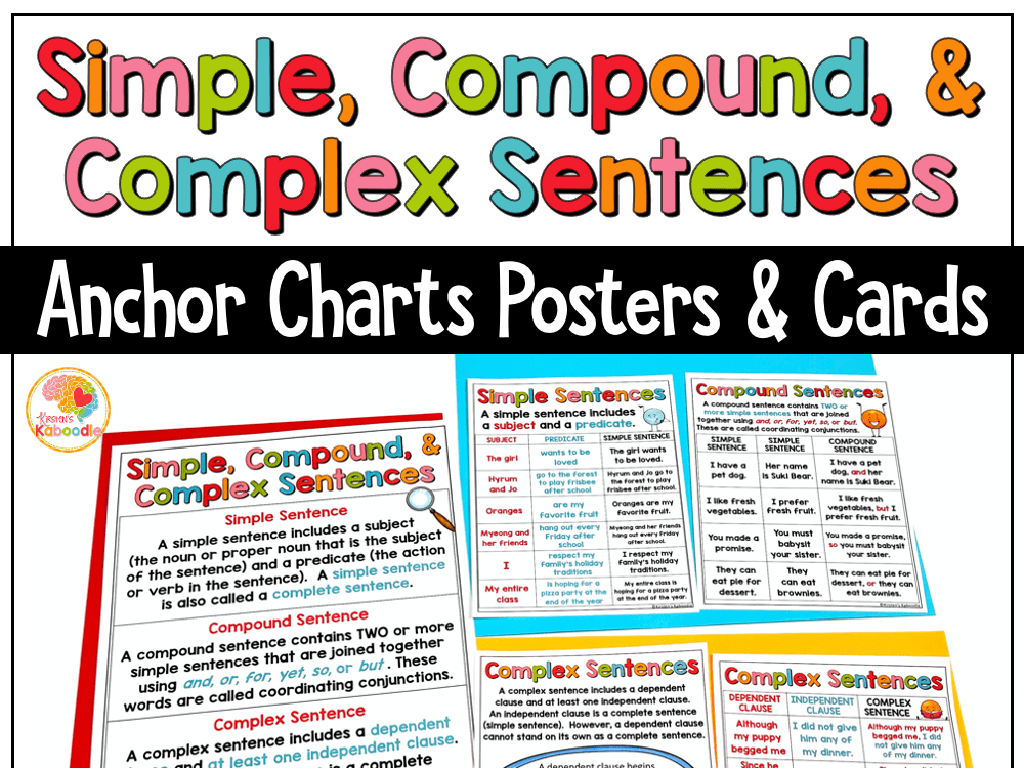Order Adjectives
Subject: Language arts
Grade: Seventh grade
Topic: Adjectives And Adverbs
Please LOG IN to download the presentation. Access is available to registered users only.
View More Content
Welcome to Adjectives!
– Greetings, Language Arts explorers!
– What are adjectives?
– Words that describe nouns, like ‘blue’ or ‘happy’.
– Discovering Order of Adjectives
– Adjectives have a specific order in sentences.
– Why does order matter?
– Correct order makes sentences clear and understandable.
|
Begin the class with a warm welcome and an engaging introduction to the world of adjectives. Explain that adjectives are descriptive words that give us more information about nouns, such as color, size, shape, etc. Introduce the concept of the Order of Adjectives, which is the sequence that native speakers usually use when they use multiple adjectives to describe a noun. Emphasize the importance of this order by explaining that it helps maintain clarity in communication. Provide examples of sentences with adjectives in the correct and incorrect order to illustrate the difference. Encourage students to think of adjectives they use every day and consider their placement in sentences.
Exploring Adjectives
– Adjectives: Descriptive words
– Words that give more information about nouns, e.g., ‘blue sky’, ‘loud music’.
– Examples in sentences
– ‘The fluffy cat slept soundly.’ – ‘fluffy’ describes the cat.
– Enhance writing with adjectives
– They add vividness to our sentences, making them more engaging.
– Why adjectives matter
– Adjectives help readers visualize and feel connected to your writing.
|
This slide introduces the concept of adjectives to the students, emphasizing their role in adding color and detail to writing. Start by defining adjectives as words that modify nouns to give more information about them. Provide clear examples by showing sentences with and without adjectives to highlight the difference they make. Discuss how adjectives can change a reader’s perception and make writing more interesting and engaging. Encourage students to think of their favorite stories and the descriptive words that bring those narratives to life. The goal is to help students understand the value of adjectives in making their writing more vivid and expressive.
The Order of Adjectives
– Adjectives have a specific order
– Standard order: Quantity to Purpose
– Quantity, Quality, Size, Age, Shape, Color, Origin, Material, Purpose
– Sentences with multiple adjectives
– ‘Three large, old, square, brown, wooden tables’
– Practice ordering adjectives
– ‘A small, red, sleeping bag’
|
When teaching the order of adjectives, emphasize that adjectives must be placed in a specific sequence when more than one is used to describe a noun. Introduce the standard order, starting with quantity and ending with purpose. Provide clear examples to illustrate the correct placement of adjectives in a sentence. For instance, ‘Three large, old, square, brown, wooden tables’ demonstrates the order of Quantity, Size, Age, Shape, Color, Material. Encourage students to create their own examples and practice rearranging adjectives to fit the standard order. This will help them write more clearly and effectively. In the next class, review their sentences and discuss any challenges they encountered.
The Importance of Adjective Order
– Adjective order affects meaning
– ‘A big old green antique car’ vs ‘An antique green old big car’
– Incorrect order causes confusion
– ‘A delicious large round chocolate cake’ sounds natural, not ‘A chocolate large delicious round cake’
– Standard order ensures clarity
– Practice correct adjective placement
– Let’s rearrange adjectives in sentences to see how it affects understanding
|
This slide emphasizes the significance of the correct order of adjectives in a sentence. When adjectives are placed in the wrong order, it can lead to misunderstandings or awkward sentences that don’t sound right to native speakers. By teaching the standard order of adjectives (quantity, quality, size, age, shape, color, proper adjective, and purpose), we help students communicate more effectively. Use examples to show how the meaning changes with different orders. Encourage students to practice by giving them sentences to correct and by creating their own examples. This will help reinforce the concept and improve their writing skills.
Practice Time: Ordering Adjectives
– Interactive adjective order activity
– Identify correct order in example sentences
– Create sentences with adjectives
– Use a variety of adjectives in your own sentences
– Group work: Unjumble the adjectives
– Work together to find the natural order of adjectives
– Share and discuss as a class
|
This slide is designed to engage students in practicing the order of adjectives through interactive activities. Begin with an interactive activity where students identify the correct order of adjectives in provided sentences. Then, encourage students to create their own sentences using multiple adjectives, ensuring they apply the correct sequence. For group work, provide jumbled sentences and have students collaborate to arrange the adjectives correctly. After the activities, have a class discussion to share answers and reinforce learning. As a teacher, facilitate the activities, provide guidance, and ensure each student participates. Possible activities: 1) Matching adjectives to nouns, 2) Ordering adjectives in a sentence race, 3) Adjective sorting game, 4) Creating a ‘silly sentences’ board with mixed-up adjectives, 5) Peer review of created sentences for correct adjective order.
Let’s Play: Adjective Order Challenge
– Engage in the Adjective Order Challenge
– Race to arrange adjectives in the correct sequence
– Collaborate in pairs or groups
– Teamwork enhances learning and makes it fun
– Discuss game results
– Review which sentences were tricky and why
– Reflect on learning outcomes
– Share insights gained from the activity
|
This interactive game is designed to reinforce the concept of ordering adjectives according to standard English conventions. Students will work together, fostering a collaborative learning environment. After the game, lead a discussion to review the correct order of adjectives in the sentences they worked on, highlighting any common mistakes. Encourage students to reflect on the strategies they used and what they learned. This activity not only solidifies their understanding of adjective order but also promotes critical thinking and peer-to-peer teaching. Possible variations of the game could include timed challenges, sentence creation contests, or using a point system for additional engagement.
Class Activity: Adjective Art
– Create a visual sentence representation
– Present artwork and explain adjective order
– Use colors, shapes, or images to show adjective order
– Understand adjective order through art
– Example: ‘A small, red apple’ could be a tiny apple painted red
– Engage in peer learning and feedback
|
This activity is designed to help students learn the proper order of adjectives in a fun and interactive way. By creating a visual representation of a sentence, students will be able to physically arrange adjectives in the correct order. Encourage creativity in their artwork. After creating their art, each student will explain the order of adjectives they used, reinforcing their understanding. This peer-to-peer learning session will also allow students to give and receive feedback, further solidifying their grasp of the concept. Possible variations of the activity could include group work, using different mediums, or creating a class gallery of the artwork for discussion.
Homework: Mastering Adjective Order
– Write 10 sentences with adjectives
– Use varied adjectives categories
– Include colors, sizes, opinions, shapes, etc.
– Follow standard adjective order
– Opinion, size, age, shape, color, origin, material, purpose
– Use the guide for correct sequence
|
This homework assignment is designed to reinforce the lesson on the proper ordering of adjectives in sentences. Students are tasked with creating 10 original sentences that include multiple adjectives from different categories such as size, color, and opinion. They should arrange these adjectives according to the standard sequence taught in class. Remind students to use the guide provided during the lesson, which outlines the correct order of adjectives: opinion, size, age, shape, color, origin, material, and purpose. This exercise will help students internalize the rules and apply them in their writing. For the next class, plan to review some of the sentences together to ensure understanding and correct usage.
Wrapping Up: Order of Adjectives
– Recap of adjective order rules
– Significance in writing clearly
– Proper order makes descriptions more natural and understandable.
– Addressing unanswered questions
– Feedback on today’s activities
– Reflect on what we learned and how to apply it.
|
As we conclude today’s lesson on the order of adjectives, it’s crucial to summarize the rules we’ve learned. Emphasize the importance of following the conventional order of adjectives in descriptive writing to ensure clarity and readability. Open the floor for any lingering questions students may have, providing clear and concise answers. Offer feedback on the class activities, highlighting both strengths and areas for improvement. Encourage students to practice using adjectives in the correct order in their writing assignments to reinforce today’s lesson.

